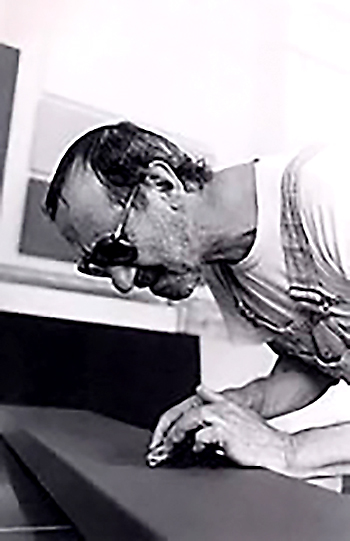|
He moved to Rome in 1958 where he got in touch with the art world getting to know Alberto Burri and to spend time in his studio. These inspirations gave rise, in the early Sixties, to an initial production of works comprising various materials. In these years he also spent long periods of time in London, Paris and Basel.
In the early Sixties, in line with contemporary experiences at the international level motivated by a shared desire to free artistic expression from tradition and pre-established codes through the acquisition of monochromy and relief as the sole compositive forms, his language defined and structured itself around a geometric element, the ellipse, which was to become the code of his artistic work.
In 1963 Simeti participated in the “Review of Figurative Arts of Rome and Lazio”, the Premio Termoli and the exhibition “Arte Visuale” in the Palazzo Strozzi in Florence, thus sharing the dynamics of visual and structural research close to the programmed art and the New Trend. Simeti participated in several exhibitions which were part of this current, such as “New Trend 3” in Zagreb in 1965, and the exhibitions held in the Il Cenobio Gallery in Milano, in Modena and in Reggio Emilia in 1967, as well as other important international art shows dedicated to that area of research, including “Programmed Art - Aktuel 65” and “White on White” in Bern in 1965 and 1966.
His participation in the “Zero Avantgarde” project, which made its debut in 1965 in Lucio Fontana’s studio in Milan, then followed by exhibitions in the galleries Il Punto of Turin and Il Cavallino in Venice, played an even greater role in featuring Simeti’s work as part of this specific scenario. In 1965, once he had moved to Milano, Simeti held his first solo exhibition in the Wulfengasse Gallery in Klagenfurt. The next year he exposed in the Galleria Vismara with a catalogue presentation by Giuseppe Gatt.
Between 1966 and 1969, he was invited as Artist in Residence by the Fairleigh Dickinson University and he spent long periods of time in New York where he set up a studio and produced numerous art works, within the rigorous poetic which he had been gradually defining.
Exposed in numerous galleries in Italy (Il Chiodo in Palermo, Giraldi in Livorno, Stefanoni in Lecco), as from the second half of the Sixties, his distinctive work started attracting great attention in Switzerland and in Germany, where his fortune was to grow over the years (in 1971 he held a show in the prestigious M Gallery of Bochum, at Loehr in Frankfurt, in the Bettina gallery in Zurich).
In 1971, in line with the climate of contestation of the period, Simeti staged a performance in the La Bertesca gallery in Genoa with the “Destruction of a sailplane”, storing its rests in blue, signed and numbered cans. However, this event did not entail any radical transformation of his work on surfaces and volumes, although it was to reflect a further sense of rarefaction of the projecting elements, witnessing closer bonds with the poetics of minimalism.
In the early Seventies he presented his work in other individual exhibitions in Bergamo, Verona, Rottweil, Dusseldorf, Oldenburg, Köln, München, and participated in a number of group exhibitions, such as “Extension” in the Casa del Mantegna in Mantua, thus confirming his participation to the research carried out in the constructive milieu.
During these years, Simeti’s work was shape-up mainly as consequential research, in the transition from single elements to diptychs and polyptychs with a projecting element, often decentralized, and with an experimentation of different formats and outlines, reaching effects of greater spatial complexity during the Eighties.
|
|
 |